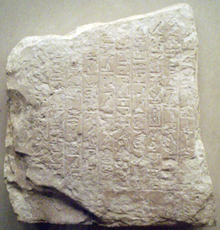
Back Decrets de Coptos Catalan Koptosdekrete German Coptos Decrees English Décrets de Coptos French Maklumat Coptos ID Koptoški odloki Slovenian

Los Decretos de Coptos son 18 reales decretos completos o fragmentados del Antiguo Egipto que van de la Dinastía VI (2345–2180 a. C.) a la Dinastía VIII (c. 2170 a. C.).
Los primeros fueron emitidos por Pepi I y Pepi II para favorecer al clero del templo de Min, mientras que otros se datan en el reinado de varios faraones de las dinastías VII y VIII, y se ocupan de varios favores que concedieron a un importante oficial de Coptos llamado Shemay y a sus familiares.[1][2] Los decretos reflejan la decadencia del poder de los faraones a inicios del Primer periodo intermedio de Egipto.
Los decretos de Coptos no deben ser confundidos con el Decreto de Coptos de Nubjeperra Intef, un documento único datado en la Dinastía XVII de Egipto.
- ↑ Alan Gardiner, Egypt of the Pharaohs: an introduction, Oxford University Press, 1964, p. 108; quote: "But perhaps the most persuasive evidence of their short-lived domination is offered by some inscriptions discovered by Raymond Weill at Coptos in 1910-11. Under the ruins of a structure of Roman date were found carefully stowed away a number of decrees carved in hieroglyphic on slabs of limestone, some dating from the reign of Pepy II, and most of them designed to protect the temple of Min and its priesthood from interference and the corvee. But among them as many as eight were apparently dispatched on the same day in the first year of a King Neferkare, the last king but one in the series of the Abydos list. The addressee was in each case the vizier Shemai and each royal command was concerned either with him or some member of his family. One of the decrees confirmed him in his vizierate in all the twenty-two nomes of Upper Egypt, while another recorded the appointment of his son Idi to the post of Governor of Upper Egypt in the seven southernmost nomes. A third decree grants precedence over all other women to Shemai's wife Nebye, who is described as a 'King's eldest daughter', and perhaps even more remarkable is a fourth making elaborate arrangements for the funerary cult of both husband and wife in all the temples of the land. There is no hint of unrest or political disturbance in any of these texts, though we may possibly read into them a desperate anxiety on the king's part to conciliate one specially powerful Upper Egyptian magnate."
- ↑ Toby Wilkinson, The Rise and Fall of Ancient Egypt: The History of a Civilisation from 3000BC to Cleopatra, London, Bloomsbury, 2010, ISBN 978-0-7475-9949-4, pp. 121–22.